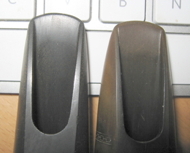
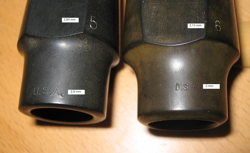
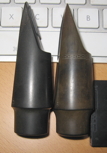
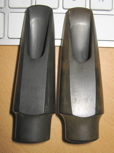
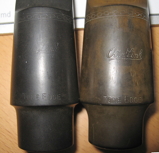
The slimmer one on the left is older and a truer EB. Judging from the baffle I would say the other one is still an EB but a later blank.
You have a large USA Florida made "straight sig" piece on the left. Also known as the "slant body" or "Florida blank" pieces. They came in two types, the earlier ones with the horizontal milling lines, and the later ones with a fatter tip rail and the vertical lines. The next pieces were the slim body "small USA" pieces (came in "21SW 5th St."), which are more like the big USA pieces. Then comes the piece on the right - the "fat body" pieces. After that they gained a number under the table and lost a bit of baffle and shortly after they changed the rubber compound to the (mostly plastic) junk made today.
